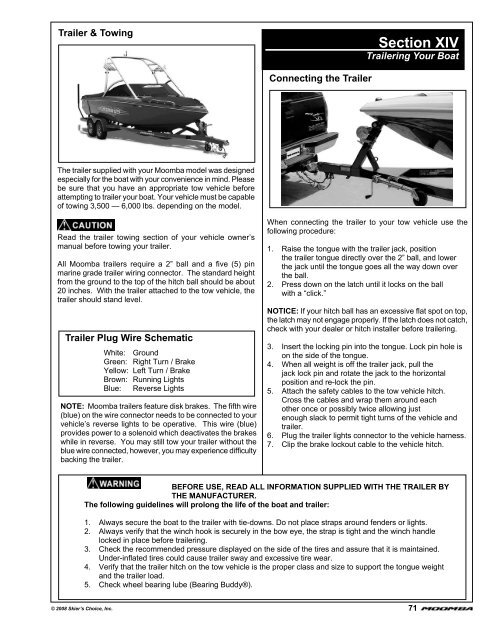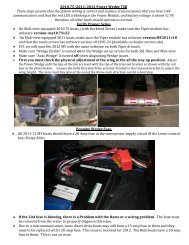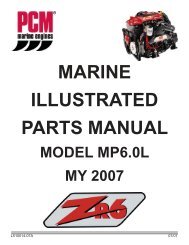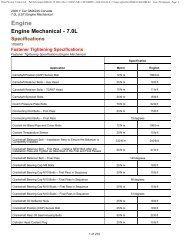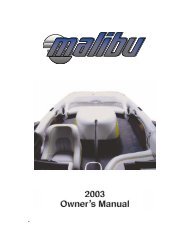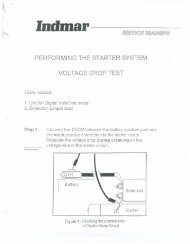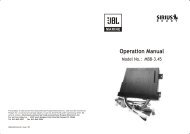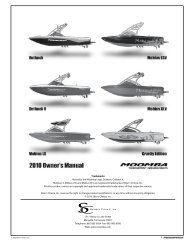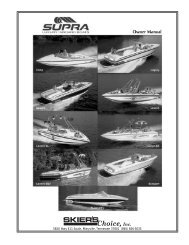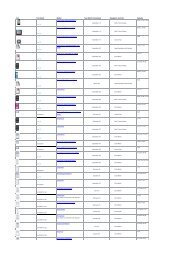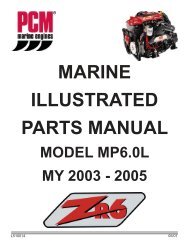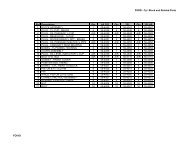You also want an ePaper? Increase the reach of your titles
YUMPU automatically turns print PDFs into web optimized ePapers that Google loves.
Trailer & Towing<br />
Section XIV<br />
Trailering Your Boat<br />
Connecting the Trailer<br />
The trailer supplied with your <strong>Moomba</strong> model was designed<br />
especially for the boat with your convenience in mind. Please<br />
be sure that you have an appropriate tow vehicle before<br />
attempting to trailer your boat. Your vehicle must be capable<br />
of towing 3,500 — 6,000 lbs. depending on the model.<br />
Read the trailer towing section of your vehicle owner’s<br />
manual before towing your trailer.<br />
All <strong>Moomba</strong> trailers require a 2” ball and a five (5) pin<br />
marine grade trailer wiring connector. The standard height<br />
from the ground to the top of the hitch ball should be about<br />
20 inches. With the trailer attached to the tow vehicle, the<br />
trailer should stand level.<br />
Trailer Plug Wire Schematic<br />
White: Ground<br />
Green: Right Turn / Brake<br />
Yellow: Left Turn / Brake<br />
Brown: Running Lights<br />
Blue: Reverse Lights<br />
NOTE: <strong>Moomba</strong> trailers feature disk brakes. The fifth wire<br />
(blue) on the wire connector needs to be connected to your<br />
vehicle’s reverse lights to be operative. This wire (blue)<br />
provides power to a solenoid which deactivates the brakes<br />
while in reverse. You may still tow your trailer without the<br />
blue wire connected, however, you may experience difficulty<br />
backing the trailer.<br />
When connecting the trailer to your tow vehicle use the<br />
following procedure:<br />
1. Raise the tongue with the trailer jack, position<br />
the trailer tongue directly over the 2” ball, and lower<br />
the jack until the tongue goes all the way down over<br />
the ball.<br />
2. Press down on the latch until it locks on the ball<br />
with a “click.”<br />
NOTICE: If your hitch ball has an excessive flat spot on top,<br />
the latch may not engage properly. If the latch does not catch,<br />
check with your dealer or hitch installer before trailering.<br />
3. Insert the locking pin into the tongue. Lock pin hole is<br />
on the side of the tongue.<br />
4. When all weight is off the trailer jack, pull the<br />
jack lock pin and rotate the jack to the horizontal<br />
position and re-lock the pin.<br />
5. Attach the safety cables to the tow vehicle hitch.<br />
Cross the cables and wrap them around each<br />
other once or possibly twice allowing just<br />
enough slack to permit tight turns of the vehicle and<br />
trailer.<br />
6. Plug the trailer lights connector to the vehicle harness.<br />
7. Clip the brake lockout cable to the vehicle hitch.<br />
BEFORE USE, READ ALL INFORMATION SUPPLIED WITH THE TRAILER BY<br />
THE MANUFACTURER.<br />
The following guidelines will prolong the life of the boat and trailer:<br />
1. Always secure the boat to the trailer with tie-downs. Do not place straps around fenders or lights.<br />
2. Always verify that the winch hook is securely in the bow eye, the strap is tight and the winch handle<br />
locked in place before trailering.<br />
3. Check the recommended pressure displayed on the side of the tires and assure that it is maintained.<br />
Under-inflated tires could cause trailer sway and excessive tire wear.<br />
4. Verify that the trailer hitch on the tow vehicle is the proper class and size to support the tongue weight<br />
and the trailer load.<br />
5. Check wheel bearing lube (Bearing Buddy®).<br />
© 2008 Skier’s Choice, Inc.<br />
71


